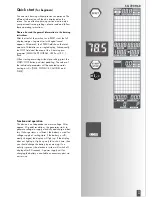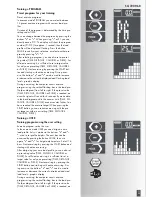
35
GB
SG 7209-68
Training Instructions
This device has particularly been designed and developed
for leisure time sportsmen. It is excellently suited for cardio-
vascular training.
The training methodically has to be organised on the princi-
ples of stamina training. This will predominantly cause
changes and adaptations of the cardiovascular system. This
includes the reduction of the resting pulse frequency and of
the load pulse.
This gives the heart more time for filling the ventricles and for
the blood circulation of the cardiac musculature (through the
coronary vessels . Moreover, depth of breathing and the vol-
ume of air that can be breathed in (vital capacity) are
increased. Further positive changes take place in the meta-
bolic system. In order to achieve these positive changes, the
training has to be planned according to certain guidelines.
Planning and control of your training
The basis for your training planning is your current physical
fitness condition. Your family doctor can diagnose your per-
sonal fitness by means of an exercise tolerance test, which
will constitute the basis for your training planning. If you
have not undergone an exercise tolerance test, high training
exertion and/or overstraining must be avoided in all cases.
The following rule should be considered in your planning:
stamina training is controlled via the scope of exertion as
well as via the level / intensity of exertion.
Regarding exertion intensity
The intensity of exertion should preferably be checked in
your fitness training via your heart’s pulse rate. The maximum
heart rate per minute of > 220 minus age must not be
exceeded. The optimum training pulse is determined by age
and training target.
Training target: fat burning/weight reduction
The optimum pulse frequency is calculated using the
empirical formula (220 – age) x 0.65.
Advice: fat burning for energy supply only gains signifi-
cance after a minimum training period of 30 minutes.
Training target cardio-vascular fitness:
The optimum pulse frequency is calculated using the empiri-
cal formula (220 – age) x 0.75.
The intensity is predetermined in your training by means of
the braking levels, ranging from 1-16. As a beginner, you
should avoid too high braking level settings for your training,
as this will quickly lead to exceeding the recommended pulse
rate range. Start by using a low braking level setting and
then approach your optimum training pulse step by step. Do
not forget to regularly check during your fitness training
whether you still range within the intensity area according to
the above stated recommendations.
Sports physicians consider the following load factors to be
positive for fitness:
Pulsediagramm
Fitness and Fat Burner
220
200
180
160
140
120
100
80
Pulse
Age
20 25 30 35 40 45 50 55 60 65 70 75 80
Maximalpulse
(220 minus Age)
Fitnesspulse
(75% of Max.Pulse)
Fat combustion pulse
(65% of Max.Pulse)
90
Beginners should not start with training units of 30 to 60
minutes.
A beginner training could be organised as follows during
the first four weeks:
In order to have a personal training documentation, you
can enter the training values achieved in the performance
table.
Prior to and after every training unit gymnastic exercises
lasting approx. 5 minutes serve the warming up and/or
cooling down. There should be a day without training
between two training units, if you later on prefer to train
three times a week for 20 - 30 minutes each. Otherwise
nothing can be said against a daily training.
Frequency
Duration
daily
10 min
2-3 times weekly
20-30
min
1-2 times weekly
30-60
min
Training frequency
Extent of training session
3 times a week
2 minutes of training
Break of 1 minute for physical exercises
2 minutes of training
Break of 1 minute for physical exercises
2 minutes of training
3 times a week
3 minutes of training
Break of 1 minute for physical exercises
3 minutes of training
Break of 1 minute for physical exercises
2 minutes of training
3 times a week
4 minutes of training
Break of 1 minute for physical exercises
4 minutes of training
Break of 1 minute for physical exercises
3 minutes of training
3 times a week
5 minutes of training
Break of 1 minute for physical exercises
4 minutes of training
Break of 1 minute for physical exercises
4 minutes of training
4th week
3rd week
2nd week
1st week



































